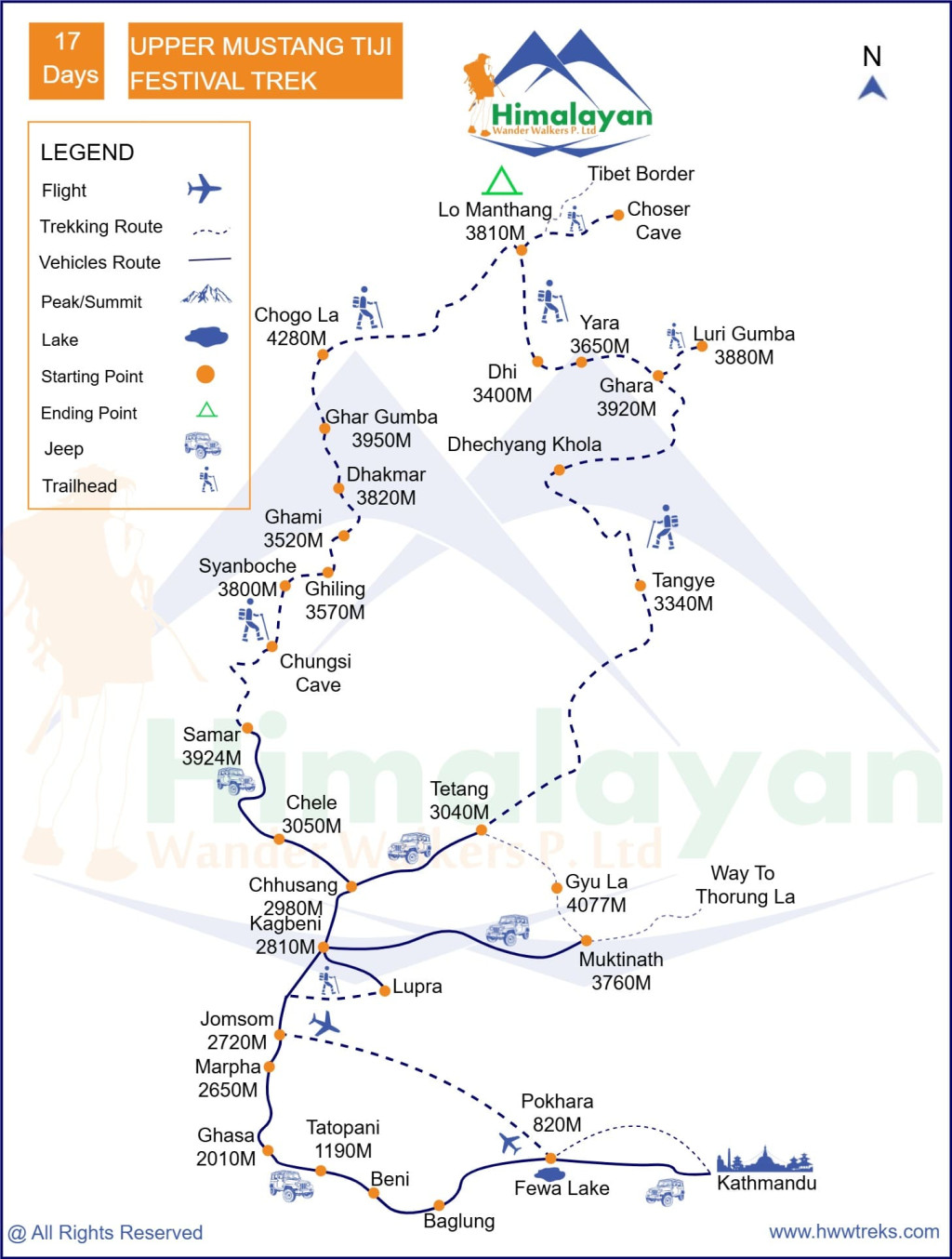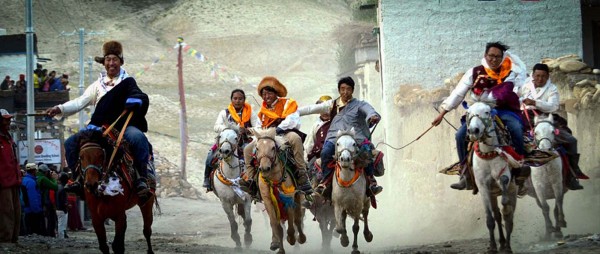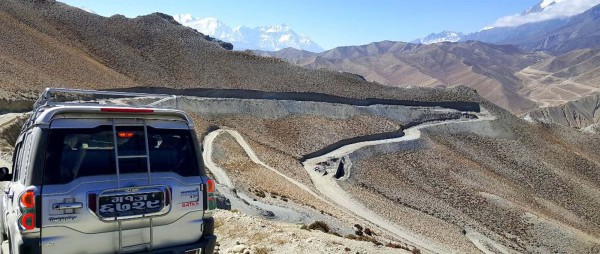Important Information
Region
Mustang Region Treks
Duration
17 Days
Max Altitude 4000 Meters
Best Season May-July
Activity Per Day
4-5 Hours Walk
Grade
Level Level 3
Group Size
2 - 12 people
Transportation Bus & Flight
In the heart of Mustang, the Tiji Festival is one of the region’s most vibrant and spiritually significant events, attracting people from all over the villages and even countries to witness the ceremony.
Are you looking for local travel agency to organize your Tiji Festival Trek to Upper Mustang in the year 2026 and 2027?
The date for New Tiji Festival Trek 2026 and 2027 is already updated. The Tiji festival Trek year 2026 will be celebrating on the june 21st, 22nd, and 23rd. Inquiry us for 2027 date
This festival is celebrated twice a year—once by the community (Lo Cho Dhun) known as the Tiji Festival, and once inside the monastery, which is known as the New Tiji Festival.
The Story of the New Tiji Festival in Mustang
Long ago, in the Mustang, there was only one Tiji festival celebrated, “ the Lho Tso Dhun Tiji.” This festival was a sacred tradition, a time when the local people came together to witness the powerful rituals performed by the monks of Chode Monastery.
In those days, the Lho Tso Dhun community sponsored the festival. They believed in the spiritual strength of the Tiji rituals, which were meant to drive away evil spirits and bring peace and harmony to the land. The festival occurred in an open space among the villagers. The chants of the monks, the swirl of colorful costumes, and the deep beats of drums brought the whole valley to life. But as time passed, the Lho Tso Dhun people could no longer afford to sponsor the grand event. Though the community could not continue their support, the monks felt the importance of keeping the tradition alive. They decided to continue performing the Tiji rituals on their own, quietly within the sacred grounds of the monastery, and the prayers continued to echo through the monastery halls.
Eventually, the Lho Tso Dhun community resumed its sponsorship. The public celebration of the Lho Tso Dhun Tiji Festival returned with all its color and energy, the mask dances, the ceremonies, and the gathering of villagers once more under the open sky. Yet something had changed. The monks had been performing the rituals inside the monastery for several years and believed it was important to continue what had become a new tradition of its own. Rather than stopping one celebration for the other, both were sustained — the original, community-based Lho Tso Dhun Tiji Festival and the monastery-led rituals known as the New Tiji Festival, which, according to the lunar calendar, are celebrated on the 27th, 28th, and 29th of the 3rd month, while another is observed on the 7th, 8th, and 9th of the 5th month, respectively.
And so, because of devotion, resilience, and a deep respect for tradition, Mustang now celebrates not one but two Tiji Festivals every year, each carrying the same sacred purpose, yet each with its unique spirit and story.
Read about the Tiji Festival community.
Compared to the first Tiji festival (Lo Cho Dhun Tiji festival), this New Tiji Festival attracts a smaller audience, both local people and tourists. This Tiji festival is also celebrated for three days with the same schedule, mask dances, and rituals, but with fewer attendees, less crowding, and a more intimate experience with the same spiritual essence.
Both versions follow the same powerful three-day ritual:
Day 1 – Invocation of the Protector
Monks perform chants and rituals to call upon Dorje Jono, a deity believed to protect the region from evil.
Day 2—Battle Against Evil
Dramatic mask dances depict Dorje Jono’s fight against demonic forces, symbolizing the victory of good over evil.
Day 3 – Banishment of Evil
The climax: a sculpture representing evil is cast out, marking peace and renewal for the land and its people.
Read in detail about the Three Days of Tiji Festival.
Highlight of the Second Tiji Festival trek
- Scenic Travel to the Himalayas
- Witness the Sacred Tiji Festival in Lo-Manthang
- Visit centuries-old monasteries, royal palaces, and mysterious Chosar Caves around Lo-Manthang.
- Trek through off-the-beaten-path villages like Yara and Tange
- Visit Luri Gompa cave monastery, and cross scenic high-altitude landscapes.
- Pilgrimage to Muktinath Temple
- Taste Local Life in Marpha
Upcoming Second Tiji Festival dates for the years 2026 and 2027 are given below in the table.
| S.N | Tiji Festival Year | Tiji Festival Happening Dates |
| 1 | Second Tiji Festival 2026 | 21st, 22nd, and 23rd, June 2026 |
| 2 | Second Tiji Festival 2027 | Inquire us |
| 3 | Second Tiji Festival 2028 | Inquire us |
Include
Airport pick up and drop off
Taxi/bus to the start and end of the trek
English-speaking government license holder trekking guide
One porter for two persons
Trekking guide’s and porter’s insurance during the trip
TIMS trekking permit, Annapurna conservation permit, Special permit of USD 500
Sightseeing entrance fee
Kathmandu -Pokhara tourist bus return, land transportation fare in itinerary
Domestic flight from Pokhara to Jomsom and back to Pokhara
Accommodation during the trek
Fooding (breakfst, lunch and dinner) during trek
Hotel in Kathmandu, Pokhara
Exclude
Meals & drinks during the trek and in Kathmandu (unless stated otherwise under ‘The trip cost includes’)
Personal trekking equipment
Travel/medical insurance
Emergency rescue evacuation
Phone calls
Photography and video charge
Internet
Monastery entry fee
International air ticket
Tips for your trekking guide & porters at the end of the trek
If you’re forced to extend your trek due to bad weather or natural disaster circumstances, we are not liable to pay any compensation or otherwise be responsible for any expenses you may incur
Anything not mentioned in the ‘includes section’
Route Map

Important Information
CHECKLISTS FOR NEW TIJI FESTIVAL TREK
- Valid passport (valid for six months from the date of your trip)
- MasterCard, Visa Credit, and Debit Cards are accepted in Nepal. However, some cash is highly recommended.
- Mobile (if your cell phone is from CINGULAR USA or ATNT (USA) operators, then your cell phone will work in Nepal.)
- Clothing (Layered clothes, windproof and waterproof jackets, fleece pullovers, thermal base layers, hiking pants, shorts, headwear, footwear, and other items according to your needs)
- Personal Items and Toiletries (First-Aid Kit, Iodine tablets or a UV purifier to treat water, Sun Protection)
- Travel and Health Insurance
- Trekking gear and equipment(if you have your own trekking gear and equipment, such as trekking poles, sleeping bag, and shoes, then you can bring them; else you can rent them in Thamel, Kathmandu). Read more for trekking gears and peak climbing gears.
Guiding, Food, and Lodging During Tiji Festival
In Nepal, all trekking supplies—teahouse trekking means staying and eating in local lodges. We stay in single rooms where possible, but often you will have to share. The rooms are basic; normally, they are just beds with pillows and blankets. A few have electric lights, and all have a spacious dining room-lounge. We eat at teahouses, and although the food is usually plentiful and delicious, the menu is not expensive. They offer a variety of potatoes, rice, and noodle dishes, as well as soup and seasonal vegetables. Beers and local spirits are often available, but that will be at your own cost. A variety of cereals, bread, and egg dishes are generally available for breakfast. There are also snacks available, such as basic biscuits, chocolate, and soft drinks, and in some areas, you will find fresh fruit in season. It is normal to meet your porter in the teahouse where you will stay overnight. So, pack your necessary things in your daypack.
DRESS CODE FOR VISITING MONASTERIES AND TEMPLES IN NEPAL
- Shirt (either half or full sleeve)
- Full pants/long skirts
- Any type of shoes with socks
- No Hats, No Umbrella, No Slippers, No t-shirts, No short skirt, and No half-pants
- Photographs are allowed in the courtyard only.
Frequently Asked Question
Tiji, also known as Tenpa Chirim, is a religious Buddhist event celebrated in Lo-Manthang, Upper Mustang, aimed at removing negative energy and maintaining peace within the valley.
The Second Tiji Festival lasts for three days: on the first day, the monks perform a dance called “Tso Chham”; on the second day, the monks perform a dance called “Na Cham”; and on the final day, the entire village and monks assemble in an open field for the banishment of the demon. Read in detail about the days of the Tiji festival.
Yes, the second Tiji festival in the Upper Mustang Package can be customized to meet your needs. We can modify the itinerary based on your preferences, whether you want to shorten or extend the trek or add extra rest days. If you're interested in specific destinations, such as monasteries or villages, we can adjust the route to include those as well. Just let us know what you're looking for, and we’ll be happy to accommodate your wishes: “Customize Your Trip.”
Yes, you need a Restricted Area Permit and an ACAP Permit to enter Upper Mustang, which can be easily obtained from a government-licensed company in Kathmandu or Pokhara. These permits are required to ensure safety and preserve the region’s unique culture and environment. Read more about trekking permits and their cost in the Mustang Region.
Altitude sickness can occur in regions above 2,500 meters, and the Second Tiji Festival in the Upper Mustang Tour takes you to elevations over 4,200 meters, so you might face some symptoms of altitude sickness, and acclimatization is important. This tour is designed with rest days to help you adjust. Staying hydrated, avoiding exertion, and listening to your body are essential. If symptoms of altitude sickness occur, your guide will assist in descending to a lower altitude for recovery.
Yes, you can explore additional locations and extend your Second Tiji Festival tour. You can visit various villages, caves, and monasteries in Mustang or take a trip to Muktinath, Jomsom, Tilicho Lake, Larkey Pass, and many more.
Apart from the Second Tiji Festival, one can also witness the Community (Lo Cho Dhun) Tiji Festival, which is held before the Second Tiji Festival during the 3rd month of the lunar calendar, and the Yartung Festival, also known as the Horse Riding Festival, which is celebrated a month after the Second Tiji Festival.
No questions found matching your search. Try different keywords or browse all questions above.
| {{type.min}} - {{type.max}} Pax {{type.name}} - {{type.desc}} | {{type.display_price}} per people |
Extra prices:
Let us help you decide Inquiry
You might also like

- 17 days
- Mustang Region Treks
Tiji Festival in Upper Mustang
Are you looking for local travel agency to organize your Tiji Festival Trek to Upper Mustang in the year 2026 and 2027? The date for Tiji Festival Trek 2026 and 2027 is already updated. The Tiji festival Trek year 2026 will be celebrating on the 14th, 15th and 16th May 2026. According to the...




